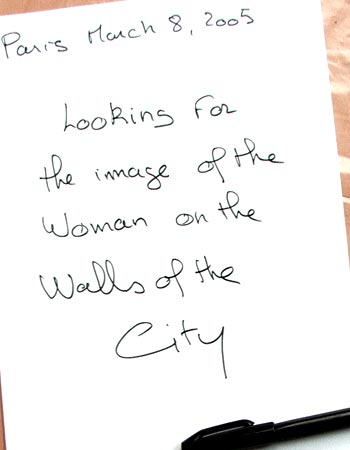
long à télécharger entièrement, fonctionne
avec du son / length to be entirely downloaded, works with sound
| |
|

|
|
|
long à télécharger entièrement, fonctionne
avec du son / length to be entirely downloaded, works with sound
|
|
< retour / back
Extrait des revendications :
Vincent Bioulès, artiste, dans une tribune publiée par le journal Le Monde du 28 octobre 2004, s’écriait « le Louvre n’appartient plus aux artistes » et s’indignait de la décision de mettre fin à l’accès gratuit pour les artistes.
En préfiguration à d’autres musées nationaux, la suppression de l’accès gratuit au Louvre pour les artistes et les enseignants vient couronner une longue suite de régressions (restriction de la gratuité pour tous à un dimanche par mois, compression et précarisation du personnel, fermeture des salles par roulement, privatisation de certains services) transformant un établissement public dont la mission doit être la plus large diffusion de la culture en entreprise commerciale dont le but est de rentabiliser les publics.
Les artistes ont bénéficié de l’entrée gratuite au musée du Louvre dès son ouverture en 1793. Si cette gratuité a connu des interruptions, elle était rétablie depuis plusieurs décennies. La gratuité a, heureusement, été préservée pour les personnes “fragiles socialement”, étudiants, chômeurs, rmistes. Pourtant, la fragilité économique du secteur des arts plastiques, la situation précaire des artistes, des vacataires de l’éducation nationale et des pigistes de la presse sont une réalité notoirement reconnue.
Ce rassemblement avait pour but de demander que tous les publics retrouvent l’accès gratuit aux collections permanentes chaque dimanche.
Le Louvre utilise largement son autonomie tarifaire pour mener une politique de plus en plus mercantile. En février 2004, le prix d'entrée augmentait de 13% - ce qui fait du Louvre l'un des musées les plus chers au monde…
----
Œuvre présentée :
Installation de Maurizio Cattelan
Exposition Contrepoint
English version -------------------------------
Excerpt from the claims:
Vincent Bioulès, artist, published by the newspaper le Monde of October 28, 2004, exclaimed "the Louvre does not belong to the artists more" and was indignant at the decision to put an end to the free access for the artists.
In prefiguration with other national museums, the removal of the free access to the Louvre for the artists and the teachers comes to crown a long succession of regressions (restriction of the exemption from payment for all on one Sunday per month, compression and precarisation of the personnel, closing of the rooms by bearing, privatization of certain services) transforming a publicly-owned establishment whose mission must be the broadest diffusion of the culture in trade undertaking of which the goal is to make profitable the public ones.
The artists profited from the admission free to the museum of the Louvre as of its opening en1793. If this exemption from payment knew interruptions, it had been restored for several decades. The exemption from payment, fortunately, was preserved for fragile people the "socially", students, unemployed, rmists. However, the economic brittleness of the sector of the visual arts, the precarious situation of the artists, the frees-lance of national education and the freelance journalists of the press are a manifestly recognized reality. The purpose of this gathering was to require that all the public ones find the free access to the permanent collections each Sunday.
The Louvre largely uses its tarif autonomy to follow a policy more and more mercantile. In February 2004, the entrance fee increased by 13% - what does of the Louvre one of the most expensive museums in the world...
----
Work presented: Installation of Maurizio Cattelan